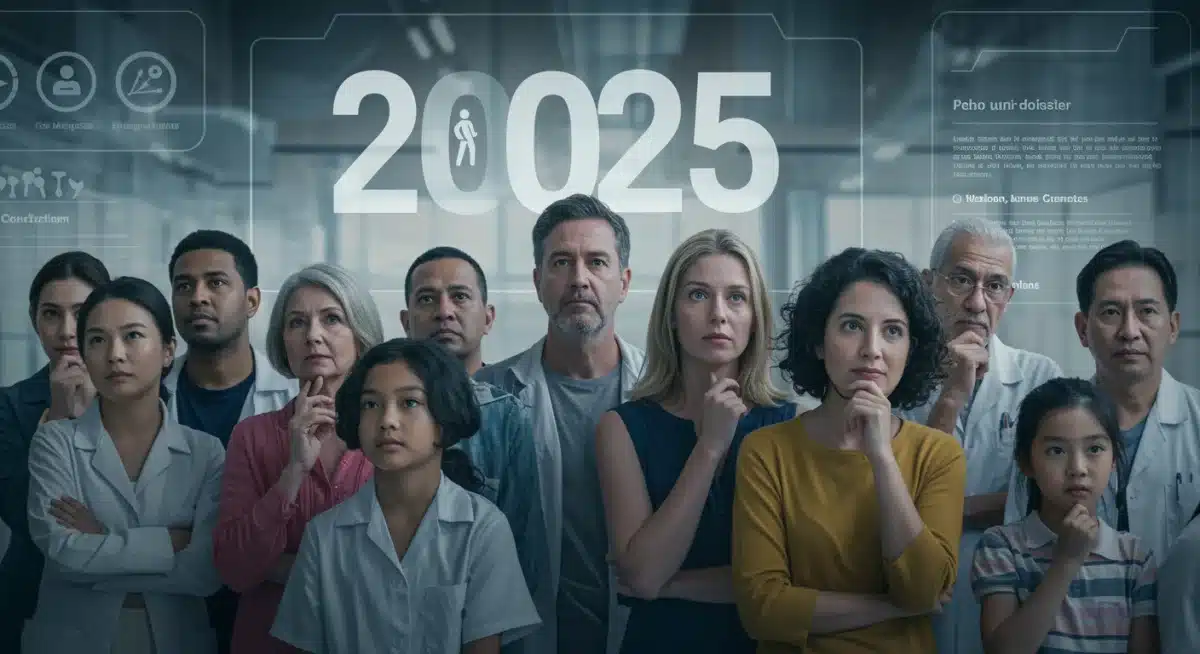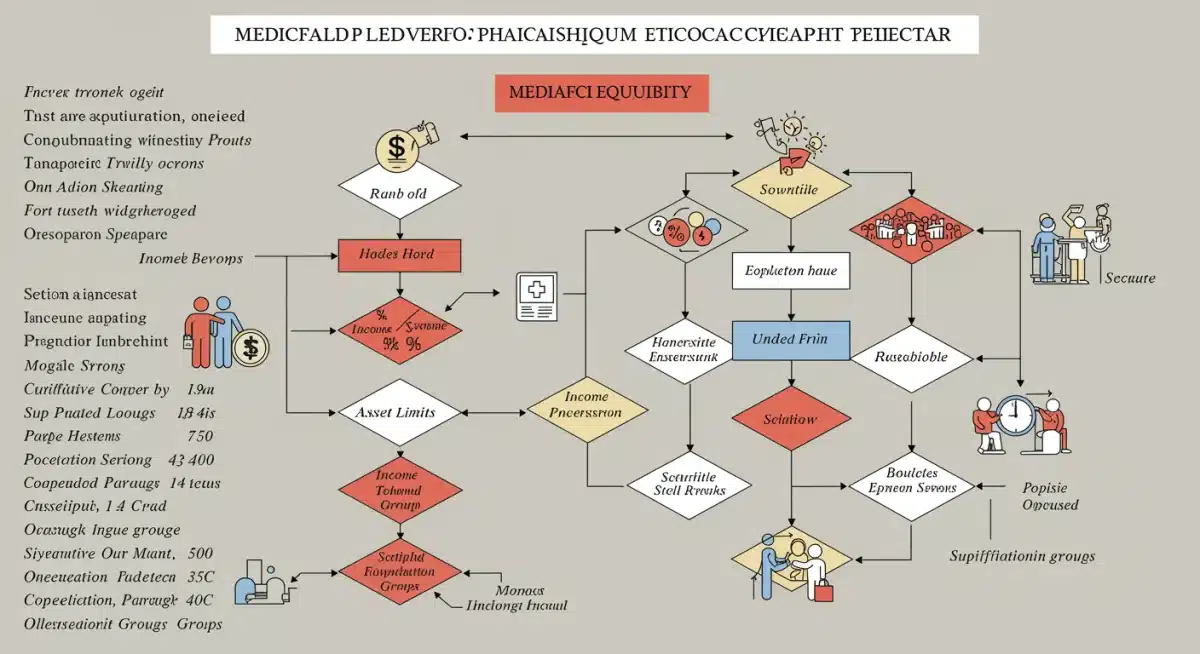New Medicaid Expansion Rules 2025: Eligibility Changes

The new Medicaid Expansion Rules for 2025 are set to significantly alter eligibility criteria for millions of Americans, making it crucial to understand the upcoming changes and how they might affect access to vital healthcare services.
Are you one of the millions of Americans who rely on Medicaid for essential healthcare coverage, or are you considering applying? The landscape of healthcare support is always evolving, and understanding the Medicaid Expansion Rules 2025 is more critical than ever. With significant updates on the horizon, these changes are poised to impact approximately 3 million individuals across the United States. This article will delve into what these recent updates mean for eligibility, coverage, and how you can prepare to ensure continued access to the care you need.
Understanding the core of Medicaid expansion
Medicaid, a joint federal and state program, provides healthcare coverage to millions of low-income Americans, including children, pregnant women, seniors, and individuals with disabilities. The Affordable Care Act (ACA) introduced a significant expansion of Medicaid, allowing states to extend eligibility to nearly all non-elderly adults with incomes up to 138% of the federal poverty level (FPL). This expansion has been a cornerstone of healthcare access for many, but its rules are not static.
The upcoming changes for 2025 reflect a continuous effort to refine the program, addressing both financial sustainability and the evolving healthcare needs of the population. These adjustments are often driven by legislative actions, economic shifts, and ongoing evaluations of the program’s effectiveness. For individuals, staying informed about these modifications is essential to avoid disruptions in coverage.
The historical context of Medicaid expansion
Initially, Medicaid eligibility was tightly linked to specific categories like welfare recipients. The ACA’s expansion marked a dramatic shift, moving towards an income-based standard that significantly broadened the program’s reach. This expansion was optional for states, leading to a patchwork of coverage across the nation.
- Initial ACA expansion aimed to cover millions of uninsured adults.
- States had the option to adopt the expansion, leading to varied coverage.
- Federal government covered a significant portion of expansion costs.
Understanding this historical context helps to frame the current updates, as they often build upon or react to the successes and challenges experienced since the ACA’s implementation. The goal remains to provide a safety net, but the mechanisms through which this is achieved are continually under review.
In conclusion, the foundation of Medicaid expansion is rooted in providing comprehensive healthcare to vulnerable populations. The 2025 rules are a continuation of this commitment, albeit with new parameters that necessitate careful attention from beneficiaries and potential applicants alike.
Key eligibility changes for 2025
The Medicaid Expansion Rules 2025 bring several critical adjustments to eligibility criteria that could directly affect who qualifies for coverage. These changes are designed to address various factors, including evolving economic conditions, state-specific needs, and federal budget considerations. It’s important to differentiate between federal guidelines and state-level implementations, as states retain significant autonomy in how they administer their Medicaid programs within federal parameters.
One of the most anticipated changes involves potential modifications to income thresholds. While the 138% FPL benchmark for expanded Medicaid states is generally stable, some states may introduce new calculations or considerations for specific groups. This could mean that individuals who previously qualified might find themselves above the new limit, or conversely, some who were just outside the threshold might now be eligible.
Adjustments to income and asset limits
Income and asset limits are fundamental to Medicaid eligibility. For 2025, there are discussions around how these limits will be adjusted, particularly in non-expansion states or for specific programs within expansion states. These adjustments typically aim to reflect the cost of living and inflation, but they can also be a point of contention in policy debates.
- Potential changes to Modified Adjusted Gross Income (MAGI) calculations for certain households.
- Review of asset limits for older adults and individuals with disabilities, which can be complex.
- Introduction of new deductions or disregarded income types that could affect eligibility.
These financial adjustments underscore the need for applicants to meticulously review their financial situations against the updated criteria. Even minor changes in income or assets could shift an individual’s eligibility status, requiring a proactive approach to understanding the new rules.
Furthermore, changes to specific population categories might also be introduced. For instance, there could be revised definitions for individuals with disabilities or new provisions for pregnant women and children, aiming to ensure coverage for the most vulnerable. These shifts emphasize that eligibility is not a one-size-fits-all concept and can vary significantly based on individual circumstances and state policies.
In summary, the 2025 eligibility changes require a thorough understanding of both federal and state-level specifics regarding income, assets, and population categories to accurately assess one’s qualification for Medicaid.
Impact on 3 million Americans: Who is affected?
The projected impact of the Medicaid Expansion Rules 2025 on 3 million Americans is a significant concern for policymakers and beneficiaries alike. This figure represents a broad spectrum of individuals, ranging from those who might lose coverage to those who could become newly eligible or experience changes in their benefits. Understanding who these 3 million individuals are is key to grasping the full scope of these updates.
Primarily, the affected population includes low-income adults in states that have expanded Medicaid, as well as specific demographic groups like pregnant women, children, and individuals with disabilities, regardless of their state’s expansion status. Changes in income thresholds or asset limits, even slight ones, can have a ripple effect, leading to re-evaluations of eligibility for many.
Potential shifts in coverage status
For some, the new rules might mean transitioning off Medicaid and onto the Affordable Care Act (ACA) marketplace, where they might qualify for subsidies. For others, it could mean a loss of coverage if they no longer meet the revised criteria and do not have other viable healthcare options. Conversely, certain policy adjustments could open doors for new applicants who previously didn’t qualify.
- Individuals currently receiving Medicaid who are nearing the income threshold.
- New applicants attempting to qualify for the first time under revised rules.
- Those in states considering or implementing new Medicaid waivers or demonstration projects.
The impact is not uniform. It heavily depends on the state of residence, as each state has some flexibility in how it implements federal Medicaid guidelines. A change that disproportionately affects one demographic in one state might have a minimal effect in another, highlighting the complex nature of the program.
Furthermore, the 3 million figure underscores the need for robust outreach and education efforts. Many individuals may not be aware of the impending changes until they receive a notice of redetermination or denial. Proactive communication from state Medicaid agencies and advocacy groups will be crucial to help people navigate these transitions effectively.
In conclusion, the 2025 changes will create a dynamic environment for millions of Americans, necessitating careful attention to individual circumstances and state-specific policies to understand the full impact on coverage.

Navigating the application and re-enrollment process
With the Medicaid Expansion Rules 2025 coming into effect, understanding the application and re-enrollment process becomes paramount. For current beneficiaries, annual redeterminations are a standard part of maintaining coverage, but the new rules may introduce additional complexities or requirements. For new applicants, familiarizing oneself with the updated paperwork and necessary documentation is crucial for a smooth process.
The process typically involves submitting an application, either online, by mail, or in person, providing documentation of income, household size, and other relevant information. Under the new rules, it’s possible that certain forms or required proofs might be updated, or there could be a greater emphasis on specific types of verification to ensure compliance with the revised criteria.
Tips for a smooth application and re-enrollment
Preparing in advance can significantly ease the burden of applying or re-enrolling. Gathering all necessary documents, understanding potential changes to income calculations, and being aware of deadlines are critical steps. State Medicaid offices and community organizations often provide assistance with these processes.
- Keep all financial documents, such as pay stubs, tax returns, and bank statements, organized and accessible.
- Respond promptly to any requests for information from your state Medicaid agency.
- Seek assistance from local navigators or community health centers if you have questions or need help with the application.
Moreover, states are often required to notify beneficiaries of impending changes and redetermination processes. Paying close attention to mail and official communications from your state Medicaid office is vital to avoid unexpected lapses in coverage. Missing a deadline or failing to provide requested information can lead to a termination of benefits, even if you are still eligible.
The re-enrollment process, in particular, can be a point of vulnerability for many. During the recent unwinding of the pandemic-era continuous enrollment provision, millions lost coverage due to procedural reasons, rather than ineligibility. The 2025 rules aim to streamline some of these processes but beneficiaries should remain vigilant.
In conclusion, a proactive and organized approach to application and re-enrollment, coupled with staying informed about state-specific guidance, will be essential for navigating the Medicaid system under the 2025 rules.
State-specific variations and what they mean for you
While federal guidelines establish the broad framework for Medicaid, the Medicaid Expansion Rules 2025 will continue to exhibit significant state-specific variations. This means that what applies to an individual in one state might be different for someone in another, even if their financial situations are similar. These variations are a direct result of states’ autonomy in implementing and managing their Medicaid programs, often reflecting local political climates, economic conditions, and healthcare priorities.
Some states have fully embraced the ACA’s Medicaid expansion, extending coverage to a broader low-income adult population. Others have not expanded, leading to coverage gaps where many low-income adults fall into a ‘coverage gap,’ earning too much for Medicaid but too little for ACA marketplace subsidies. The 2025 rules may see some non-expansion states reconsidering their stances, while expansion states might fine-tune their programs.
How to find your state’s specific rules
Identifying your state’s specific Medicaid rules is a critical step in understanding your eligibility and benefits. Official state government websites, particularly those run by the state’s Medicaid agency or health and human services department, are the most reliable sources of information. These sites typically provide detailed guides, FAQs, and contact information for assistance.
- Visit your state’s official Medicaid or Health and Human Services website.
- Look for updated eligibility charts, application forms, and program details for 2025.
- Contact your local Medicaid office or a community health center for personalized guidance.
Beyond eligibility, state variations can also extend to the scope of covered services. While federal law mandates coverage for certain essential health benefits, states have the option to offer additional services, such as dental care for adults, vision benefits, or specific behavioral health treatments. These differences can significantly impact the overall value of Medicaid coverage for beneficiaries.
Furthermore, states may implement different waiver programs or demonstration projects that introduce unique eligibility pathways or service delivery models. These innovative approaches are often designed to address specific state-level challenges or to test new ways of providing care, adding another layer of complexity to the national Medicaid landscape.
In conclusion, understanding the nuances of your state’s Medicaid program is indispensable. Relying on official state resources and seeking local assistance will ensure you have the most accurate and up-to-date information regarding the 2025 rules.
Resources and support for beneficiaries
Navigating the complexities of the Medicaid Expansion Rules 2025 can be daunting, but a wealth of resources and support systems are available to help beneficiaries and potential applicants. These resources range from official government channels to community-based organizations, all dedicated to assisting individuals in understanding their healthcare options and securing coverage. Knowing where to turn for help can make a significant difference in a successful application or re-enrollment.
The first point of contact for many should be their state’s Medicaid agency. These agencies are directly responsible for administering the program and can provide the most accurate and up-to-date information on eligibility, application processes, and covered services. Their websites often feature extensive FAQs, downloadable forms, and contact details for local offices.
Key support channels to utilize
Beyond state agencies, various non-profit organizations and community health centers play a crucial role in providing hands-on assistance. These entities often have navigators or trained counselors who can offer personalized guidance, help with paperwork, and answer specific questions about individual circumstances.
- State Medicaid offices: Official source for rules, applications, and program details.
- Community health centers: Offer in-person assistance with applications and understanding benefits.
- Non-profit advocacy groups: Provide educational materials, advocacy, and sometimes legal aid.
- Healthcare.gov: While primarily for marketplace plans, it can help determine if you qualify for Medicaid or CHIP.
It is also beneficial to utilize online tools and federal resources. Websites like Healthcare.gov can serve as a starting point to determine potential eligibility for Medicaid or the Children’s Health Insurance Program (CHIP) based on income and household size. These platforms often redirect users to their state’s specific application portal.
Furthermore, staying informed through reputable news sources and healthcare policy updates can help beneficiaries anticipate changes and prepare accordingly. Many organizations provide newsletters or alerts specifically tailored to Medicaid news, ensuring individuals are always aware of the latest developments.
In conclusion, a multi-faceted approach to seeking information and support, combining official government resources with community assistance, will empower beneficiaries to confidently navigate the 2025 Medicaid rules and maintain their essential healthcare coverage.
Preparing for the future of Medicaid: long-term outlook
As the Medicaid Expansion Rules 2025 take effect, it’s important to consider the long-term outlook for the program and how future policy decisions might continue to shape healthcare access. Medicaid is a dynamic program, constantly subject to legislative debates, economic pressures, and evolving public health needs. Beneficiaries and advocates should remain engaged and informed about these broader trends to anticipate future changes.
The ongoing discussions around federal funding for Medicaid, the role of states in program administration, and the integration of new healthcare technologies will all contribute to the program’s evolution. These factors collectively influence not only eligibility criteria but also the scope of services, provider networks, and overall access to care for millions of Americans.
Anticipating future policy shifts
Predicting the exact nature of future Medicaid changes is challenging, but certain trends offer clues. For instance, there’s a continuous push for value-based care models, which could influence how services are reimbursed and delivered. Additionally, efforts to address health disparities and social determinants of health might lead to new benefit categories or enhanced support services.
- Continued focus on cost-effectiveness and program efficiency.
- Potential for further integration with other social support programs.
- Impact of technological advancements on service delivery and access.
The political landscape also plays a significant role. Changes in presidential administrations or congressional majorities can lead to shifts in healthcare policy priorities, potentially affecting Medicaid’s structure and funding. Staying abreast of these political developments can provide insights into the program’s trajectory.
Moreover, demographic changes, such as an aging population and increasing prevalence of chronic conditions, will inevitably place new demands on Medicaid. The program will need to adapt to these evolving needs, potentially through specialized programs or expanded services for specific populations. This continuous adaptation ensures Medicaid remains relevant and responsive to the health challenges of the nation.
In conclusion, the future of Medicaid will be shaped by a confluence of policy, economic, and demographic factors. Remaining informed and adaptable will be key for beneficiaries to navigate the evolving landscape of healthcare coverage effectively in the years to come.
| Key Point | Brief Description |
|---|---|
| Eligibility Changes | Modifications to income and asset thresholds could impact who qualifies for Medicaid in 2025. |
| Affected Population | Approximately 3 million Americans across various demographics could see changes in their coverage status. |
| State Variations | Rules and benefits vary significantly by state, requiring localized research for accurate information. |
| Application Process | Proactive preparation and prompt responses are crucial for smooth application and re-enrollment. |
Frequently asked questions about 2025 Medicaid rules
The primary changes for 2025 involve adjustments to income and asset limits, as well as potential modifications to specific population categories. These updates aim to align the program with current economic realities and state-specific needs, impacting who qualifies for coverage.
Current beneficiaries may experience re-evaluations of their eligibility based on updated criteria. Some might transition to marketplace plans with subsidies, while others could face a loss of coverage if they no longer meet the revised requirements. Prompt responses to state notices are crucial.
You can find your state’s specific Medicaid rules on your state’s official Medicaid agency website or the Health and Human Services department website. These sites provide detailed information, application forms, and local contact details for assistance.
To prepare, gather all financial documents, stay informed about official communications from your state Medicaid office, and seek assistance from community health centers or navigators if you have questions or need help with the application or re-enrollment process.
Yes, resources include your state’s Medicaid office, local community health centers, and non-profit advocacy groups. Websites like Healthcare.gov can also help you determine potential eligibility for Medicaid or other programs based on your income and household size.
Conclusion
The upcoming Medicaid Expansion Rules 2025 represent a significant juncture for millions of Americans relying on this vital healthcare program. The changes, encompassing evolving eligibility criteria, income thresholds, and state-specific variations, underscore the dynamic nature of healthcare policy. While these updates aim to refine and sustain the program, they also demand proactive engagement from beneficiaries. By staying informed through official state channels, utilizing available support resources, and meticulously navigating the application and re-enrollment processes, individuals can ensure continued access to the healthcare coverage they need. The future of Medicaid will undoubtedly continue to evolve, making ongoing awareness and adaptability essential for all involved.





